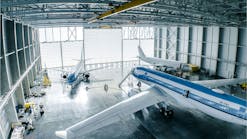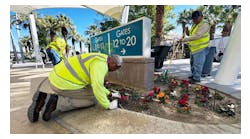Microbials 101: Fuel supplier offers a primer for FBOs, aircraft owners on causes of tank problems
Fueling/Line Ops/Safety
Microbials 101
Fuel supplier offers a primer for FBOs, aircraft owners on causes of tank problems
Special to AIRPORT BUSINESS
July 2004
Katonica’s company, a certified FAA repair station at Dallas’s Addison Field, specializes in aircraft fuel tank and fuel systems inspections and repairs from Falcon 20s to all types of corporate and commercial aircraft as large as 757s. Based on his 30 years of experience inspecting, cleaning, and rebuilding aircraft fuel systems, Katonica says the majority of corrosion on the internal surfaces of tanks and inner wings is caused by microbial growth found in water in the fuel.
“The type of jet fuel used can have even more impact on airplane resale values. If it’s got to be repaired due to corrosion problems, you’re devaluing your airplane,” he says.
“Often fuel not treated with Di-EGME can be a breeding ground for microbial growth which can in the long term lead to costly cleanup, extensive structural repairs, or a premature hot-section.
“Even if microbial growth doesn’t cause an in-flight emergency by clogging filters or gumming up fuel manifolds, its presence can boost the cost of a fuel tank inspection and clean-up by thousands of dollars.” For example, he says that contamination can require a complete change-out of the fuel manifold on the engine side of the high-pressure filters. This procedure alone can cost $10,000 to $12,000 a link.
Excessive contamination might additionally require changing fuel injector nozzles, which also adds several thousand dollars to the maintenance check, according to Katonica.
Preventative Maintenance Tips
“Owner/operators and air crews need to watch the fueling process
and check the fuel as it is pumped,” Katonica says.
To avoid water becoming a breeding ground for microbes in the jet fuel, Katonica recommends the flight crew sump their aircraft per their aircraft’s operating manual.
“If there is free water in the fuel, it will be seen in the sump because water’s heavier than fuel and it collects in the low spots where sump drains are found.
“If a black or dark-brown type of substance appears in the sump sample, the aircraft crew will know it contains bacteria,” Katonica adds.
During normal operational cycles, if the fuel manifolds become contaminated with bacterial growth, then clogged fuel injectors may prevent an even spray, causing the engines to run hotter. Even prior to any maintenance work this phenomenon of gummed up fuel nozzles can have a long-term negative impact on power output and engine operating efficiency.
Also, fuel that is contaminated with microbes can clog both the aircraft engine's low- and high-pressure filters. “If that happens, the pilot better find an airport, and quick, before the plane decides to quit flying,” Katonica says.
Jet fuel runs the gauntlet through critical parts in the fuel system where orifices need to remain free of any contaminant that might impede the fuel’s flow.
The fuel must flow freely from the fuel tank to the return line filter and then through the in-line (low pressure) filter, then moving to the fuel boost pump and onto the high pressure filter. The jet fuel then runs through the fuel manifolds and fuel injectors.
According to Global Aircraft Services, if any flow points become impeded, an aircraft’s engine may reach only 75 percent of the expected cycle life before running hot and ending up having to be removed for overhaul. Long term, this means a significant reduction in operating hours.
Contaminated fuel can also block wing-tank fuel probes and the fuel level detector, causing incorrect or erratic fuel readings. While they sometimes can be hand-cleaned with alcohol, often they just have to be replaced, he says.
Why Inspect
Owners or operators bring aircraft to Global Aircraft Services for
many reasons. Sometimes they’ll find leaks or detect bacterial
contamination they want washed out, or they’re responding to
a service bulletin. But most often it’s an FAA-required action
such as the demanding 12-year fuel tank inspection which includes
dropping all wing panels to expose the fuel tanks, checking for corrosion,
washing out tanks, and determining their integrity, then reinstalling
the panels.
Katonica starts any fuel tank inspection and repair with a cost estimate for the inspection only (ranging from $5,000).
This procedure includes updating per any service bulletin changes; resealing trunions, junctions, or nut plates, depending on the type of aircraft; and removing surface corrosion. In addition to standard cleaning, bacterial corrosion might require resurfacing and repainting integral tank interiors, or even strengthening or replacing airframe structures, if corrosion damage exceeds allowable limits. In those cases, Katonica must tell a customer why his airplane needs additional maintenance.
If additional work requires extensive cleaning this may cost an additional $10,000 to $50,000. But, if an aircraft’s wet wings and spars are badly corroded and structural repairs are required, it can cost upwards of $90,000 to $100,000 to make the aircraft airworthy, Katonica says.
Even surface bacterial contamination could involve additional costs to refurbish fuel tanks after the contamination is removed -— grinding out corrosion, ensuring remaining metal thickness meets approved engineering specifications, and repainting all surfaces.
An Arduous Process
For most aircraft, the 12-year fuel tank inspection is the most rigorous.
Katonica’s crew, for example, takes seven to ten days to do
a 12-year inspection on most “clean” Falcon 20s. Cleanup
needed on a dirty fuel tank and system could stretch over a month.
The inspection procedure is very arduous. Katonica’s crew tops off the tanks and checks wings and center sections for leaks before emptying and pressure-checking the tanks. Then, the crew “opens it up,” dropping all exterior panels to expose the airplane’s entire wet wing or fuel tank system.
After the fuel system is washed with strong chemicals to kill and clean out any bacteria, the crew visually inspects for corrosion, chipping or peeling paint, and corroded or deteriorated seals, and then makes any needed repairs.
Global Aircraft Services’ preliminary tank inspections are visual checks for contamination or corrosion. Special tests aren’t needed except to determine whether deep or extensive corrosion affects airframe integrity in badly corroded areas.
“Sometimes we have an idea of a tank’s condition before we open it up, based on clogged sump valves, how well maintained an airplane is, and where it’s been stationed,” explains Katonica. To him, a dirty sump sample may mean “bad stuff inside.” In those cases, he expects to find badly corroded metal underneath the microbial growth.
The simplest cure against microbial growth in the fuel system is prevention. “Buy only pretreated fuel can keep water out of your tanks and your fuel,” Katonica says.
Many pilots who find contaminated fuel may choose to “shock” it with biocide chemicals to kill the bacteria hitchhiking in the load of bad fuel.
“But, using uneven amounts of a straight biocide chemical in the fuel tank could actually attack the seals around the integral tank, softening them so much that they leak,” Katonica says.
“Anyone using biocides to clean fuel tank contamination better carefully double-check all measurements or they’ll be spending more money for leak repairs.”
Bacteria also can grow in fuel storage systems and refuelers that aren’t well maintained, sampled or sumped, especially in warm areas, since heat enhances microbial growth. “That stuff grows quick,” Katonica says.




